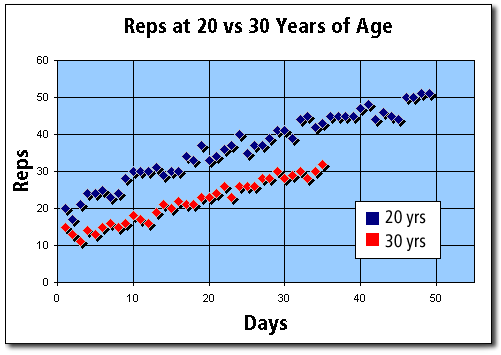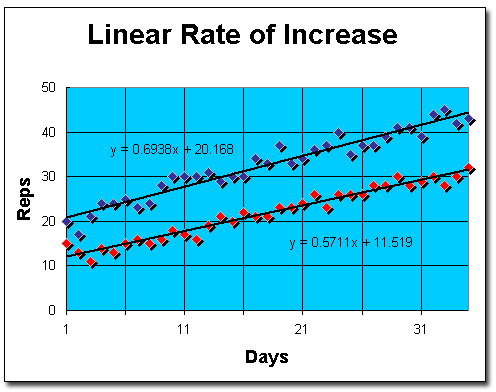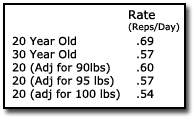 |
 |
10 Years ago, Scientific AmeriKen attempted to understand the rate by which muscles increase (Link) with exercise and decrease (Link) with inactivity. In an effort to increase the lore of knowledge in this area, Scientific AmeriKen will once again investigate the rate of muscle increase, however, with an additional 10 years of "wisdom". By hitting the bench press again, Scientific AmeriKen will hope to understand how 10 years of aging will affect the rate of muscle gain. |
 |
 | Although it is often said that one should accept one's aging with grace, Scientific Ameriken will hope to defy such nonsense and go |
|
|
|
|
 |
 | down fighting. One would reason that as we age the ability of the body to recover from damage becomes reduced, thereby slowing the rate of muscle recovery after excercise and ultimately the rate at which new muscle is created. Based on this the hypothesis would call for a decrease in rate in a 20 year old vs a 30 year old, However, seeing as Scientific AmeriKen is the subject, the hypothesis of this experiment is that age is in fact just a number and the results will be the same. |
 |
10 years ago the procedure was simple,"This experiment used a weight set, therefore, the procedure was to see how many repetitions one could do per sitting, and recording results. That process was repeated over a period of almost 2 months.!" 10 years later, not quite so. The vagueness was quite problematic in recreating this experiment; however, the following procedure was set up. First begin with 5 minute cardiovascular workout. Utilizing a free weight bench press at 115 lbs, count the total reps before re-racking the bar due to exhaustion. Further strengthen by additional trials. Attempt daily if possible for nearly 50 days. |
 |
The experiment ran for 35 days and the raw data can be viewed here (click here). The data shown in the chart below appears to indicate that the rate of increase does appear to be larger at 20 years of age vs 30.

In a better effort to compare these two sets of data, a best fit line was inserted into the plot of the first 35 days (Pictured Below). Using excel the equation of these lines was deduced showing that the rate of increase at 20 years of age was .69 reps per day versus .57 reps per day at 30 years of age.

 Due to lack of information about the 20 year old experiment, the weight that was bench pressed in the experiment is unknown. To correct for this, the data from the 20 year old experiment was adjusted in an attempt to equalize it to the 115 lbs that was benched at 30 years of age. The formula for adjustment was 20 year old data*(1-((115-beleived 20 yr old bench weight)/115)). The chart at right indicates that the 30 year old rate correlates to a 20 year old weight benching at 95 lbs and mathematically adjusted to be 115 lbs. Due to lack of information about the 20 year old experiment, the weight that was bench pressed in the experiment is unknown. To correct for this, the data from the 20 year old experiment was adjusted in an attempt to equalize it to the 115 lbs that was benched at 30 years of age. The formula for adjustment was 20 year old data*(1-((115-beleived 20 yr old bench weight)/115)). The chart at right indicates that the 30 year old rate correlates to a 20 year old weight benching at 95 lbs and mathematically adjusted to be 115 lbs.
|
 |
At first glance these data indicate that in fact the rate of increase of a 20 year old is better than that of a 30 year old. However, an unfortunate piece of data, which is at what weight is the 20 year old benching, is missing. Without this data it brings into question whether these two sets of data are comparable. Scientific AmeriKen has attempted to mathematically adjust the rates so as to compare the data sets. Using these crafty calculations a case could be made if the 20 year old data was used using less than 115 lbs than the rate of increase may actually be the same and Scientific AmeriKen is as young as ever!
However, the likelihood is that the rate of increase is
better for a 20 year old. If that is indeed the case, Scientific
AmeriKen did make some observations between exercising at
20 years of age versus 30 years of age. Differences in these
experiments include an easy undergraduate lifestyle versus
a busy graduate student lifestyle, An easy access bench
press at home versus a gym .5 miles from work, doing exercises
at any time versus experiments in the evening after a long
work day. Added to the increase social obligations at 30
years of age it can be seen that maintaining an optimal
workout schedule is difficult and can hamper results. Most
significant was at times not being at 100% strength because
of a long work day before the workout - a factor that may
lead to further experimentation in comparing rates of increase
in morning routines vs evening routines. In all the experiment
provides interesting data about aging that can hopefully
be expanded in much more compelling ways 10 years from now.
However, most importantly, this experiment illustrates the
need for why one has to take meticulous lab notes about
their experimental procedures!
|
|
|

